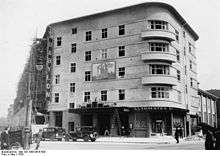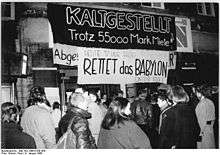Kino Babylon
 The Babylon seen from the crossing Hirtenstraße/Rosa-Luxemburg-Straße | |
| Location |
Rosa-Luxemburg-Straße 30 Berlin, Germany |
|---|---|
| Coordinates | Coordinates: 52°31′33.2″N 13°24′41.2″E / 52.525889°N 13.411444°E |
| Owner | Neue Babylon Berlin GmbH |
| Type | Film theatre |
| Capacity | 520 |
| Construction | |
| Built | 1928–29 |
| Opened | 11 April 1929[1] |
| Renovated | 1999–2001 |
| Website | |
| http://www.babylonberlin.de/ | |
The Babylon is a cinema in the Mitte neighborhood of Berlin and part of a listed building complex at Rosa-Luxemburg-Platz opposite to the Volksbühne. The building was erected 1928/29 according to plans of architect Hans Poelzig and is regarded as typical of its construction period, Neue Sachlichkeit. In 1948 the theatre was heavily renovated and served afterward as a speciality cinema in the GDR. After the auditorium had been closed because of the danger of collapse, it was refurbished and reconstructed from 1999 until 2001 in accordance with conservation guidelines. In 2002 the reconstruction was awarded the "German Award for Monument Protection". Since 2001 the Babylon is once again open to the public and used primarily as arthouse cinema, as well as a venue for the Berlinale and musical and literary cultural events. Originally the cinema held 1200 members of audience in one hall, but is today divided into two halls with 450 and 70 seats.
Planning and architecture (1927–29)

By order of building contractor Alfred Schrobsdorff (1861–1940), Hans Poelzig designed from 1927 to 1929 eight blocks for a perimeter development at the Bülowplatz (today Rosa-Luxemburg-Platz). The completed blocks included 170 apartments and 80 shops. The block where Babylon is located has the form of a right triangle, where Hirtenstraße and Kleine Alexanderstraße form the catheti and Weydingerstraße borders the block as hypotenuse. The layout of the block is given a facet at the acute-angled corner Weydingerstraße / Hirtenstraße, so that the building has a short front on Rosa-Luxemburg-Straße, where the entrance of the cinema is located at the address "Rosa-Luxemburg-Straße 30." After the destruction of World War II the block of the Babylon was the only complete survivor left from the overall design by Poelzig.[2]
The building is strongly structured horizontally by a striped enclosure of window rows and a wide overhanging moulding at the roof plate. The front is ochre-coloured plaster, with stripes painted on plaster in a light yellow shade.[2]
Full in the sense of Neue Sachlichkeit, the interior design was characterized by economical material usage and utilisation of the emotional impact of colours and forms at the same time:
From a spacious, in grey, red and yellow kept vestibule, from where two broad stairs lead upwards to the rood loft, one gets to the imposing auditorium, that is given a warm and cosy mood without many extravagant decorative forms. Wall and ceiling are painted in a shaded yellow, the gallery niche and the stalls are painted red and constrast with a narrow copper-coloured band, the balustrade of the seats is blue. The seats are covered with velvet of the same colour. The wooden working of the doors and the grilles of the heating and ventilation system are painted in red.
Poelzig also worked as set designer and architect for film and theatre of the 1920s. The most important film in collaboration with him was The Golem: How He Came into the World (1920) by Paul Wegener and Carl Boese.[3] Aside from the Babylon Poelzig designed two other cinemas: in Berlin the Capitol am Zoo (1924–26) and in Wrocław the Deli (1926/1927).
History of usage until restoration (1929–99)


In the year 1929 the Babylon opened as silent film cinema with an orchestra pit and a cinema organ for musical accompaniment. During the 1948 renovation the orchestra pit was closed and the organ dismantled. A projectionist of the Babylon, Rudolf Lunau, was from the Machtergreifung in 1933 until his arrest in 1934 a member of an illegal resistance cell of the KPD, and held meetings in "his" projection room, where he also hid opponents of the regime who went underground. At the beginning of the 1980s a metal plaque was placed in the foyer of the cinema to commemorate him.[4]
After the end of the Second World War the Babylon reopened on 18 May 1948 as première theatre under direction of the Sovexportfilm agency in Germany.[5] Until 1989 Kino Babylon served as a speciality cinema of the GDR, but also held screenings of the State Film Archive of the GDR and the Organisation of Film- and Television-makers of the GDR. For example, from 1984 to 1989 the series "offerings" from the DEFA studios for documentary films were shown among others.[6] In 1993 the auditorium had to be closed by the building authorities because of the danger of collapse. As a result, the foyer of the cinema was converted into a temporary stage with 68 seats.[7]
Restoration and current usage (since 1999)
The two-year redevelopment of the Babylon began in 1999, costing ten million Marks and was funded from the budget for urban development monument protection. Lottery development funds of two million Euros were available for armchairs, motion picture and sound technology.[8] Refurbishment measures were essential for the roof and the ceiling of the great hall. Wooden joists in the ceiling, which were not able to take weight anymore, were replaced by steel girders and a new roof was erected over them. The front was also renewed.
For the purpose of a critical reconstruction, the goal of the renovation of the interiors was not to achieve consistently an arbitrarily dated "original state", but to show intentionally the different states of constructions and eras of usage. So in the foyer the opening state of 1928 was the aim, while the auditorium was renovated in the style of the renovation of 1948: with plush chairs, stucco and gilded details.[7] The initial construction was usable as a cinema as well as a theatre and therefore had a stage house. In this room behind the screen of the great hall, the small hall was built. The orchestra pit of the great hall was restored, so that now music for films can be played live in a chamber orchestra line-up. In 1999 the Philipps cinema organ, at this time 70 years old, was restored, being the only cinema organ in Germany that is played at its original location.[9]
In May 2001 the reopening of the auditorium took place with the film Othello by Orson Welles.[9] In 2002 the association "Berlin film art Babylon" was awarded with the "silver hemisphere" by the German Award for Monumental Protection. The architect Joachim Roemer (association) and the architect Klaus Meyer-Rogge (planning and site supervision) were honored for the rescue of a "key building of cinema architecture".[10]

Today the Babylon serves also as venue for the Berlin International Film Festival (Berlinale). Thanks to the restored cinema organ the series "StummfilmKonzerte" ("silent film concerts") with the accompanist and pianist Stephan von Bothmer,[11] who inaugurated the organ on 26 May 2001 for the opening of the film The Golem: How He Came into the World, became possible. The sets of this film were designed by Poelzig.
In the year 2009 some employees, who were partly organized in the anarcho-syndicalist FAU, tried to put through higher wages and better working conditions. At the end of July 2009 the Berlin section of the FAU called to boycott the cinema.[12] The trade union ver.di signed a collective agreement for the employees starting on 1 January 2010. Since 2009 the operator of the cinema conducted a legal dispute with the FAU, which dealt with the right to self-designate itself as trade union. The Landesarbeitsgericht Berlin-Brandenburg has ascertained in October 2009 that the FAU, due to its "low imposing power", has no pay negotiating capacity. A temporary injunction, imposed by the Landgericht Berlin in December 2009, which forbids the FAU Berlin until further notice to call itself "trade union" or "base trade union",[13] was annulled by the Kammergericht in June 2010.[14]
References
- ↑ Michael Hanisch, Das Babylon. Geschichten um ein Berliner Kino mit Abschweifungen, Berlin, 2002
- 1 2 3 Entry in the monument database of Berlin, retrieved 9 July 2016.
- ↑ Hans-Peter Reichmann (Ed.), Hans Poelzig – Bauten für den Film. Frankfurt am Main: German Film Museum, 1997, ISBN 3-88799-056-0. (catalogue for the exhibition Klassische deutsche Filmarchitektur. Hunte – Poelzig – Reimann, from 5 November 1997 until 18 January 1998 in the German Film Museum, exhibition archive, retrieved 23 October 2008.)
- ↑ Michael Hanisch, Das Babylon. Geschichten um ein Berliner Kino mit Abschweifungen, Berlin, 2002, pp. 20–29.
- ↑ Beiträge zur Film- und Fernsehwissenschaft (BFF), No. 32/1988, ISSN 0232-718X, p. 156–170. Cited from DEFA foundation, cronicle 1988.
- ↑ DEFA foundation, cronicle 1984 about the opening of the series on 5 January 1984. Retrieved 24 October 2008.
- 1 2 Kerstin Krupp (8 June 1999), "Kinosaal erhält Gold und Stuck zurück". Berliner Zeitung.
- ↑ Tobias Schneider (25 January 2000), "Barock mit Goldleiste für den großen Saal". Berliner Zeitung.
- 1 2 Claudia Fuchs (24 April 2001), "Der große Saal des „Babylon“ öffnet am 4. Mai". Berliner Zeitung.
- ↑ "Babylon Berlin – Preis für Denkmalschutz 2002 verliehen". Bauhandwerk, 13 December 2002, ISSN 0173-5365.
- ↑ StummfilmKonzerte Berlin.
- ↑ Sebastian Heiser (30 July 2009), "Großes Kino schon vor dem Film". die tageszeitung, local news section Berlin.
- ↑ Birgit Schmidt (7 January 2010), "Eine Gewerkschaft, die der Chef nicht mag". jungle world.
- ↑ Jörn Boewe (11 June 2010), "Koalitionsrecht verteidigt". junge Welt.
External links
| Wikimedia Commons has media related to Kino Babylon. |